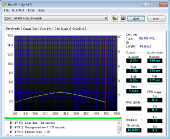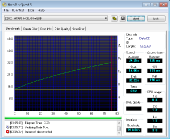Testing
Testing bench:
| Processor | Intel Core i7 920 @ 2.66 GHz |
| RAM | Corsair Dominator 6 GB @ 1600 MHz |
| Hard Drive | Kingston SSDNow 40 GB SSD |
| PSU | Kingwin MACH 1 700 W |
| Case | Lian Li PC-A77 |
The testing categories would be as follows:
- Nero DiskSpeed 5.0 – on a Blu-Ray Disk
- Nero DiskSpeed 5.0 – on a DVD+R
- Nero DiskSped 5.0 – on a CD-R
The blue ray title I chose for the testing of the BD Reading Capabilities of the drive was the movie Inglorious Basterds whcih is a 44.98 GB long Blu-Ray Dual Layer (DL) title. As you can see from the results the reading speed peaked at the 23 GB at which point it was reading at 4X – the maximum reading speed of the drive. From the results obtained one can only interpret that the peaking point is the start of a second layer on the Blu-Ray disk which would explain the slow down.
The DVD used for the testing was a DVD+R approximate 4.36 GB in size. Unlike in the case with the Blu-Ray disk, the iHOS104 achieved maximum speed toward the end of the drive. The maximum speed of 8.09X w as record right at the end of the disk mark while the opening speed was 3.35X. The average speed of the drive was 6.05X which is enough to watch DVDs but slower speeds will definitely translate into slower seek times if you are switching between the scenes.
The CD benchmark exhibited similar results to those of the DVD results. The benchmark started off as 14X and gradually incremented to 32X through the disk. The speeds reached their peak towards the end of disk at the 76 mins. The average for the entire session was 24.39X.
Conclusion
The LITE-ON iHOS104 is an excellent “foot in the door” into the Blu-Ray market. A price tag of $60.00 makes it a more costly option than most DVD drives on the market, it is, however, cheaper than the stand alone Blu Ray players. Despite the 4X Blu-Ray reading speed, it was able to play the full test sample without a problem taking approximately .2 to .5 seconds if I were to skip frames which is something that is most definitely acceptable for a reader that will mostly be reading sequential data rather than asynchronous data. While the burning and gaming enthusiasts might find the speeds of 8X and 32X a bit unsettling, I can definitely see one of these drives make its way into a home theater PC (HTPC) of sorts as it does exactly what it needs to do, nothing more, nothing, less.




It would have been nicer to test the drive with a more htpc oriented CPU (core i3 and athlon 2) and test how does the BD playback affect the system resources (mem and CPU usage)